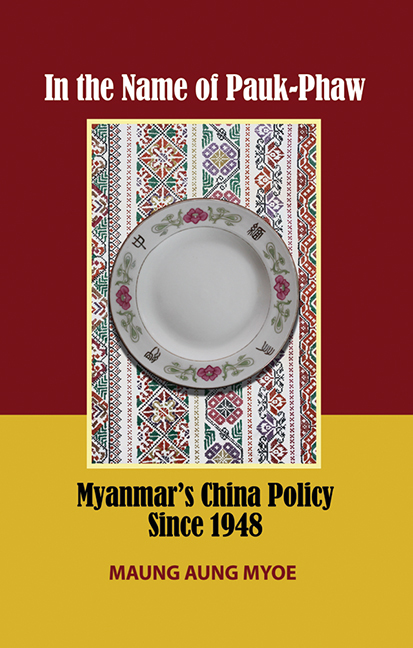Book contents
- Frontmatter
- Dedication
- Contents
- About the Cover
- Acknowledgements
- Chinese Names
- 1 Introduction
- 2 Sino-Myanmar Relations 1948–1962: The Years of Charting the Water
- 3 Sino-Myanmar Relations 1962–1988: Into the Years of Living Dangerously
- 4 Sino-Myanmar Relations 1988–2010: Towards Closer Cooperation
- 5 Conclusion
- Appendices
- Bibliography
- Index
- About the Author
1 - Introduction
Published online by Cambridge University Press: 21 October 2015
- Frontmatter
- Dedication
- Contents
- About the Cover
- Acknowledgements
- Chinese Names
- 1 Introduction
- 2 Sino-Myanmar Relations 1948–1962: The Years of Charting the Water
- 3 Sino-Myanmar Relations 1962–1988: Into the Years of Living Dangerously
- 4 Sino-Myanmar Relations 1988–2010: Towards Closer Cooperation
- 5 Conclusion
- Appendices
- Bibliography
- Index
- About the Author
Summary
After a long period of anti-colonial struggles and movements for national liberation, Myanmar finally regained her independence on 4 January 1948. Many sacrifices were made in the name of sovereignty, national self determination, and territorial integrity. At the time of Independence, one immediate task for Myanmar was to become a member of the “family of nations”; thus it applied for the membership in the world body known as the United Nations. Myanmar became a member of the United Nations on 19 April 1948. For the people of Myanmar, this signified the recognition of their country as a sovereign state in the Westphalian international system. Successive Myanmar governments since independence have based their foreign policy on “non-alignment” or “neutralism” and highlighted their “independent” nature in the conduct of diplomacy. The Myanmar government expects that the principles of sovereign equality and non-interference in internal affairs should form the basis upon which a country's foreign relations should be regulated. It is in this context that Myanmar has formulated her China policy. Nevertheless her relations with China have never been easy and have been subjected to numerous strains over the years. Historically, China established Sinocentric world order of tributary relations with political entities near and far, which was regulated by rules, customs and rituals, not by treaties. This worldview, constructed primarily upon Confucian norms, was based on hierarchy rather than equality. Lesser political entities were obliged to send tribute and offer symbolic obeisance to the Chinese emperor. Although the Sinocentric world order of tributary relations did not necessarily involve any significant political control by China, it did require the lesser political entities to recognize a hierarchical structure with China at the apex. With this historical legacy, China entered into the world of twentieth century international politics based on the Westphalian model of the theoretical sovereign equality of nation-states. Whether China will ever really reconcile her own traditional worldview with Westphalian norms is a question that has often troubled Myanmar's leaders.
Conceptual Framework
The foreign policy of a nation can be studied at various dimensions and levels. Analysis can be made on the basis of issues, actors, goals and strategies, and so on.
- Type
- Chapter
- Information
- In the Name of Pauk-PhawMyanmar's China Policy Since 1948, pp. 1 - 10Publisher: ISEAS–Yusof Ishak InstitutePrint publication year: 2011



